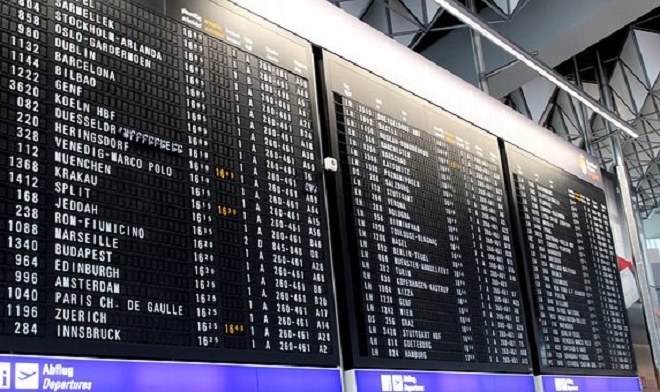The missing key to unlocking the value of in-flight Internet?
September 27, 2019: Learn how going a little more “seamless” can benefit passengers, airlines and mobile network operators alike. Find the missing key to unlocking the value of in-flight Internet in an article by David Fox, Vice President of Inflight & Connectivity Services at Deutsche Telekom and Blaz Vavpetic, consultant to the commercial aerospace and telco industries.
High quality in-flight Internet connectivity has become a major factor in airline customer loyalty as the air traveler demographic trends younger. Customer experience and good value are the measure, with significant room for improvement on both. Collaboration between airlines and mobile network operators offers each the opportunity to increase their value by taking the friction and fear out of in-flight connectivity to the delight of their overlapping customer base, a win-win-win strategy.

Table stakes
No longer a “nice to have”, airlines are now being evaluated not on the basis of whether or not in-flight Internet connectivity exists, but on its reliability and the associated passenger experience.
Beyond lucrative business travelers who have long sought the service, statistics show a trend towards a younger passenger demographic, ‘digital natives’ who expect seamless connectivity in the air and whose loyalty is value-driven and up for grabs. The bottom line… airlines must deliver a high-quality in-flight connectivity experience.
The connected passenger experience breaks down into two parts, getting connected and the quality of the connection itself. In this article, we are focusing on the former. It’s a prerequisite for the latter, which will be covered in a future post.
The friction associated with getting connected, combined with perceptions about poor performance and high costs, have kept take rates far below the advertised potential.
It seems the value for passengers is not where it needs to be. Neither is the ROI materializing (looking at ancillary revenue from passenger connectivity alone) for airlines who have often invested substantially to make the service available.
Getting connected can be a drag.
Today’s default means of getting connected in-flight is a mixture of the following flavours:
- finding the SSID (the network name) in your device’s list of available networks,
- navigating the airline’s web portal to find the option for Internet access,
- digging your credit card out of your wallet or purse (or remembering your PayPal credentials)
- typing in your payment details on a tiny keyboard while your neighbor observes
Bonus step (thankfully the Captcha requirements have been all but abolished in most airlines):
- interpreting some dancing letters and typing them into another tiny box to prove you are a human
Especially on shorter routes (the average flight time in Europe is only 70 minutes) this can feel like spending more time getting online than being online — a recipe for low passenger satisfaction.
Smart Clients & Roaming Agreements
Over the years, a few companies have worked with in-flight connectivity (IFC) providers to remove this friction by offering smartphone software (so-called “smart clients”) to automate the connection process and offering service via roaming agreements that enable passengers to get seamlessly connected with the charges applied to their home service provider.
It is a technically complex integration to implement and maintain, which has limited its availability to less than 25% of all connected aircraft, but it does yield a significantly improved user experience to the point where employers, communications service providers and consumer brands have begun sponsoring roaming access for their employees, subscribers and loyalty program members.
While the availability of smart clients and roaming relationships in general has improved the passenger experience and service take rates, the numbers show that there is still a lot of potential, as the ubiquity on the subscriber side is missing. The situation isn’t helped by the highly fragmented landscape of in-flight connectivity systems, either.

Enter Mobile Network Operators (MNOs) and Passpoint-certified Hotspot 2.0 technology
Ironically, Hotspot 2.0’s specification was released in 2011, at about the same time that in-flight connectivity on transcontinental flights (with Lufthansa) and domestic US flights (several airlines, with Gogo) took off on a larger scale. The first roaming agreements to support in-flight Internet connectivity were equally drawn up in that time frame.
So, with the technology capable of enabling seamless authentication being around for so long, why haven’t we seen more of it (read: anything at all) in the aviation context?
A question that has also been asked recently by aviation journalist Seth Miller.
The answer lies partly in Hotspot 2.0’s history: primarily used by mobile operators as a substitute technology to seamlessly off-load cellular data traffic to Wi-Fi for the past few years, there was never a thought on how this could be applied in a paid-for environment like in-flight Internet.
And, while Passpoint-certified network equipment has now found its way into most commercial aircraft, there is still a large piece missing to the puzzle: the commercial framework to support seamless or “near-seamless” technology.
Until recently, there were no mobile network operator tariffs available that included in-flight connectivity — either bundled-in or as a flat-rate option. Deutsche Telekom, one of Europe’s leading mobile network operators, has now started to include in-flight Internet connectivity as part of their subscriber product portfolio. Other MNOs will, no doubt, follow. The availability of the service as part of a bundled product immediately and positively impacts the game.
Superior user experience for the passenger / subscriber
For passengers, collaboration between airlines and their mobile operators means a better experience and more value from their mobile contract. Automated by a Smart Client or Hotspot 2.0 technology , the passenger moves from the above-mentioned “getting-connected” acrobatics to a near seamless experience. The user gets to enjoy the connectivity without any fear of bill-shock or disclosing their credit card number to their neighbor. Likely, they will have already responded to three e-mails while the next person is still entering their credentials on the portal.
Positive side-effect for airlines and connectivity providers: as the service is bundled, any deterioration of the service during the “being connected” period is more likely to be “forgiven” by the passenger. Whereas, someone who just spent 10 minutes and €10 or more buying a pass may feel an obvious lack of value.
Airlines get more value from their connectivity service.
A higher base of connected passengers automatically promotes the service to others in the cabin, even those who are not customers of that particular MNO. From personal experience, only a few airlines are doing a good job in advertising the availability of the service to their passengers. Watching someone else in the cabin getting pinged on WhatsApp may well be the missing trigger for others to get online themselves.
More quantifiable than the admittedly diffuse service stimulation example above is a strong advertising / communications benefit to the airline. An MNO that is offering bundled in-flight Internet as a differentiator will market this fact to their own customer base on a regular basis. These are potentially millions of contacts getting reminded on which airlines the subscribers can benefit from connectivity. Furthermore, airlines and telcos often share the same “large accounts” in their home country’s customer base.
Last but not least, the loyalty aspect: If I, particularly as a business user, am given the choice to travel with an airline with the bundled service available or one without, the natural preference lies with the former.
All of this adds to the monetization potential of in-flight Internet where the additional value can easily exceed the perceived foregone revenue from the sale of in-flight Internet connectivity. Of course, MNOs also expect preferential conditions on the wholesale side of the deal. With retail take-rates being what they are today, the decision on this trade-off seems a no-brainer.
MNOs create value for their subscribers.
Finally, what’s in it for the MNOs? The answer again is: value.
Again, as in the aforementioned airline context, the lion’s share of the value resides not in the resale of the connectivity itself — bundling in-flight Internet adds a lot of perceived value to an MNO’s product portfolio as a whole.
It creates chances to up-sell (when the in-flight feature is reserved to a higher than the basic subscription, for example) as well as improve loyalty. After all, a happy customer is less likely to churn and more likely to recommend their MNO’s service offering over that of the competition.
In the B2B context in particular, offering bundled access to in-flight Internet can turn out to be the deal-clincher for attracting or retaining that high-revenue large account with a lot of frequent fliers — think multinationals and consultants.
MNO-powered in-flight access and airline branding — will it blend?
As part of their core business, MNOs control subscriber identities and access management systems. They have a history of connecting roaming partners and the necessary experience in configuring mobile devices to seamlessly connect to designated Wi-Fi networks — with and without a smartphone app. Thus, MNOs are uniquely positioned to take the friction out of the in-flight Internet connection experience. Still, airlines seem afraid to bring on board partners for fear of losing ‘eyeballs’ on their (sometimes) carefully designed on-board portals (and with it the promise of ancillary revenues through ad sales and on-board services).
Mitigating the ‘lost impressions’ / ‘lost revenue’ argument is the prevalence of airline mobile apps. Most airlines invest heavily in the development and promotion of their apps for the screen-optimized delivery of on-board services such as In-Flight Entertainment (IFE). Adoption of the mobile apps also enables them to remain in contact and deliver value to their customers off-wing. Evolving them to deliver the value of the captive portal is a natural and desirable progression that will be appreciated by passengers.
Key takeaways
- The technology to enable seamless or near-seamless access to in-flight Internet has been available for quite some time now.
- It will only take off once MNOs start bundling the access, making an easy-to-understand proposition available to a large subscriber base.
- Offering easy, seamless access to mobile subscribers creates a dramatically improved passenger experience and
- generates significant value to both airlines and MNOs.
- Very often, the value created outside of the profit on the sale of Internet connectivity will outweigh the foregone revenue by a large margin.
Outlook
Talking of margins: while seamless passenger Internet access enabled by Hotspot 2.0 and other “near-seamless” technologies is important, it is only one of many in-flight connectivity use cases. On-board service offerings such as in-flight entertainment, e-commerce and on-board IoT solutions are contributing to the demand for more reliable connectivity and strengthening the case for the “Connected Aircraft”.
Commercial aviation and wireless industry groups including the Airline Passenger Experience Association (APEX) and the Wireless Broadband Alliance (WBA) continue to collaborate on both the technical and commercial way forward to achieve all of these objectives.
Read the article also on medium.com
About the authors
David Fox is Vice President of Inflight & Connectivity Services at Deutsche Telekom. Together with his team he works on improving both, the “getting-connected” as well as “being connected” aspects of the in-flight user experience. He is also DT’s programme lead for the European Aviation Network, helping to deliver the world’s first true broadband experience in the skies of Europe with partner Inmarsat. You can find David on LinkedIn at https://www.linkedin.com/in/inflightfox/
Views expressed are his own.
Blaz Vavpetic is a consultant to the commercial aerospace and telecommunications industries. He heads the Passenger Experience subcommittee of the APEX Connectivity Working Group and is the former Chief Technology Officer at iPass, a pioneer in in-flight Internet roaming access and delivery of seamless mobile connectivity. You can find Blaz on LinkedIn at https://www.linkedin.com/in/blazvavpetic/
SOCIAL MEDIA